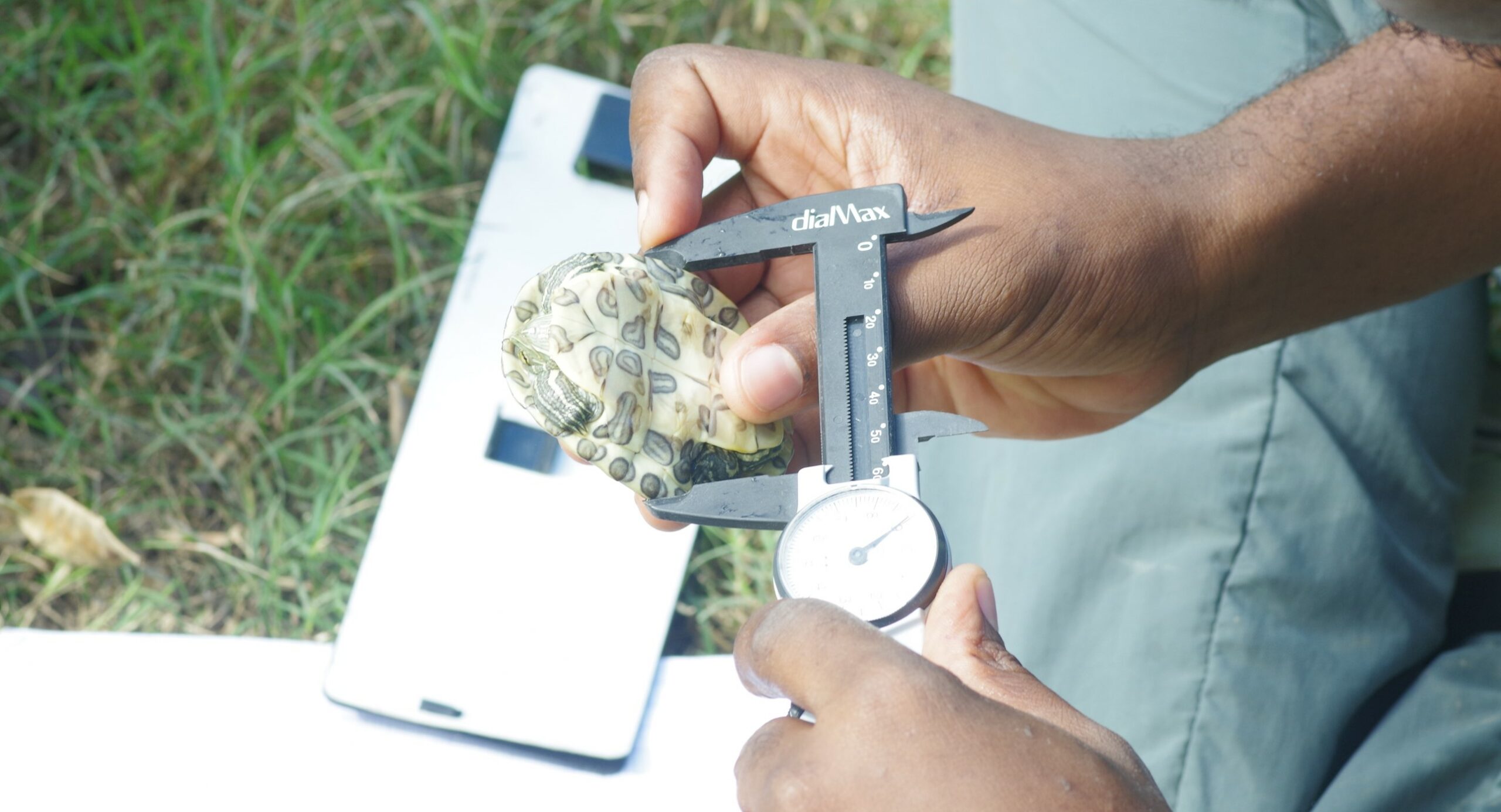In the middle of Lake Trou Caiman in Haiti, Jeffey checks his daily catch for the 40th day in a row. In the net he set up several weeks ago, a turtle with a dark green neck marbled with yellow is trapped. After being examined and measured, it will be released into the lake, but others are not so lucky. In Haiti, turtles sell well. One more danger for a species that is still poorly known.
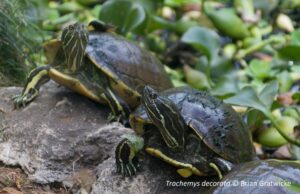
The species Trachemys decorata is endemic to Hispaniola.
The turtle is called Trachemys decorata and is found exclusively on the island of Hispaniola, shared between Haiti and the Dominican Republic. It is a poorly studied species, and little is known about its spatial distribution, its ecology or its conservation status. The freshwater turtle, already classified as vulnerable on the IUCN red list, faces numerous threats, some of which are very specific, such as the risk of hybridization with other Trachemys species and commercial exploitation, in particular as a pet or for use in voodoo practices.
To increase knowledge about the species, Jeffey M. Paul conducted an unprecedented pilot study directly in the field in Haiti, considering both wild individuals and those kept captive around the Lake Trou Caiman.
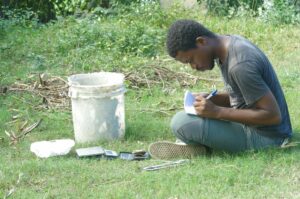
Jeffey taking measures on the field.
A total of 44 wild individuals were caught, thanks to traps and nets placed in different places covering the entire surface of the lake. Before being released, the captured turtles were measured, weighed, and examined to determine their sex. They were also marked with unique combinations of incisions on the edge of their carapace, allowing each individual to be recognized in the event of a new capture.
In addition to the captures, Jeffey and his colleague Lens questioned around thirty fishermen about their practices. These discussions in Creole helped them to better understand the economic importance of turtles. They were also able to access to 48 additional individuals, held captive by fishermen and locals.
The study provides some details on the ecology and biology of the species: the turtles show a marked preference for places in the lake with a high vegetation cover of Typhaceae. The females, represented in equal proportion to the males in the population, are generally larger, as has already been observed in similar species.
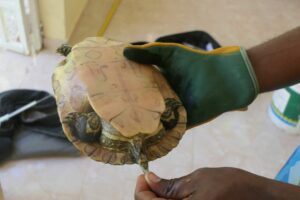
Sexing of an individual.
The study also confirms one of the dangers facing the species. Indeed, orange bands on the head were found in about 10% of individuals. Such an appearance suggests hybridization with either the species T. stejnegeri, also endemic to Hispaniola, or T. scripta elegans, an invasive turtle from the United States – two species which present red bands on their head. Genetic studies could provide a better understanding of this genetic pollution in T. decorata populations.
Above all, the study led to a better understanding of the relationship between locals and turtles. Turtles seem to constitute only a supplementary source of income for the fishermen, representing less than 10% of their income. Even among the few fishermen who have no other activity apart from fishing, none is specialized in catching turtles. However, based on their conversations with fishermen, the authors estimate that at least 1600 turtles are captured each year at Trou Caïman. Some fishermen also point out that turtles are becoming rare in the nets, raising fears of a gradual decline in the population in response to this strong pressure.
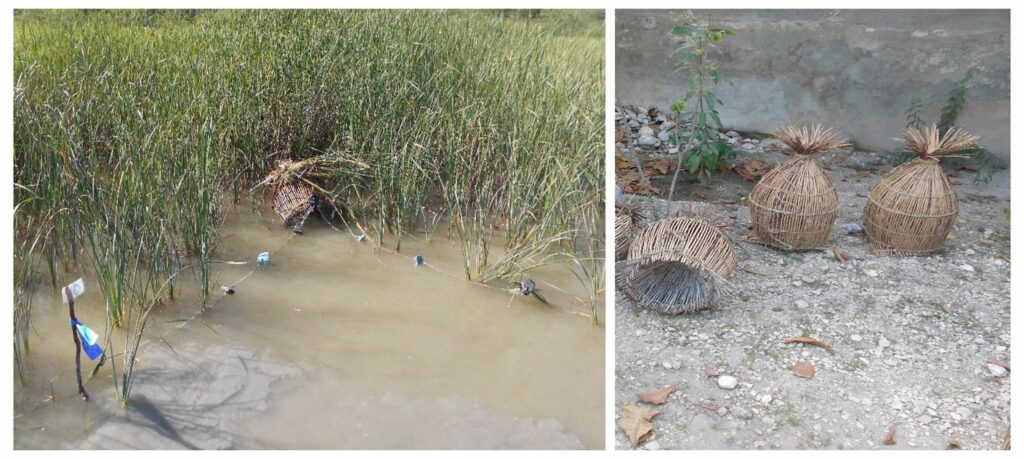
Traditional traps used during the study.
Once captured, the turtles sell for around 200 gourdes, a little less than two dollars. Some are kept captive as pets, at least initially. Those that scientists were able to access had many more injuries than wild individuals, suggesting unsuitable husbandry conditions. It is not uncommon to observe young children poorly treating the turtles. Other turtles can be found in voodoo temples and sacrificed in rituals.
The good health of turtle populations thus depends on many parameters in Haiti. The economic situation of locals is of course part of this. The importance of the voodoo religion may induce a greater demand for animals. The education of the population also plays a key role, and in particular their awareness of the environment and the importance of turtles. A solution resolving two of these three points is thus suggested by the authors: the establishment of participatory science programs with the support of local populations. By employing local fishermen and training them in the capture and marking of individuals, they would benefit from financial support while developing awareness about the preservation of the species. A solution that was already successful in other parts of the world.
Reference
Paul, J.M., Saint-Louis, L.J., Olivier, A., Célestin, W. & Cézilly, F. (2022). Conservation status of the Hispaniolan slider Trachemys decorata (Barbour and Carr 1940) at Lake Trou Caïman, eastern Haiti: first data on an endemic, poorly studied, and endangered species. Herpetological Conservation & Biology 17: 612–622.
About the authors
Of Haitian nationality, Jeffey M. Paul holds a degree in agricultural engineering and a master’s degree in ecology. He is currently conducting a doctoral thesis at the Université des Antilles, thanks to the support of the Caribaea Initiative, on the different species of Trachemys turtles found in the insular Caribbean. He benefited in the field from the support of Lens J. Saint-Louis, also holder of an agricultural engineering degree and whose work on the birds of Haiti has also benefited from the support of the association.

